INTRODUCTION
The Bottom Line
About one in four American adults today smokes cigarettes, but most seem to regret their habit saying they would like to quit and would not start smoking if they could do it over again. As for tobacco policy, attitudes can be complex, but Americans go along with a certain amount of tobacco regulation. They are growing increasingly critical of smoking in public -- but they generally think tobacco should remain legal, that tobacco companies should be allowed to advertise. They also think that smokers should be able to light up in public in designated areas, and that it is smokers, not cigarette makers, who are responsible when smokers contract tobacco-related illnesses.
Key Indicator
"Have you, yourself, smoked any cigarettes in the past week?"
Stability
After a long-term gradual decline in the rate of smoking in the U.S. from 45% a half-century ago, the percentage of adults who smoke has leveled off in recent years at about 25%. Along with a decline in the number of smokers, Gallup has recorded increased awareness of the risks of smoking (90% now believe smoking causes lung cancer, up from 41% in 1950). Public concern about the dangers of second hand smoke grew rapidly in the mid-1990s, but has subsequently trailed off. A majority of Americans still favors accommodating smokers in the workplace and hotels -- by establishing designated smoking areas. However, tolerance of smoking in restaurants, in particular, is dwindling.
Range of Opinion
The rate of smoking in the U.S. ranges from approximately 20% when looking only at those who smoke cigarettes on a regular basis to roughly one-third when broadening the definition to include those who use any kind of tobacco (cigarettes, pipe and chewing tobacco) on either a regular or occasional basis.
The percentage of Americans who seem cognizant of the serious health risks associated with smoking ranges from 74% (the number who volunteer a serious health problem when asked to name the harmful effects of smoking) to 92% (the number who answer "yes" when asked whether they believe smoking causes lung cancer).
Questions about federal regulation of tobacco yield a wide range of answers -- anywhere from one third to two-thirds support -- depending on the specific focus and wording of the question.
Differences
One's level of education is among the strongest predictors of smoking cigarettes, with roughly a third of those with no college education reporting they smoke cigarettes, compared to 26% of those with some college education, 15% with a college degree and only 10% of those with post-graduate schooling. Far fewer Americans over the age of 65 smoke than those under 65. However, it is not clear whether this age gap is due to a higher rate of quitting smoking among older Americans, or to higher death rates from smoking among older Americans.
In terms of attitudes toward smoking in public, men seem to be more tolerant than women. For instance a majority of men would set aside smoking areas in restaurants while women are more inclined to ban smoking in restaurants.
In terms of tobacco policy, self-described conservatives are more likely to side with tobacco companies than are liberals. This is seen both in conservatives greater tendency to blame smokers for their own health problems, and in their greater reluctance to want to see tobacco subject to new federal regulation, similar to prescription drugs.
Urgency (Pressure for Change)
The available poll data suggests there is little public pressure for further regulation of tobacco or smoking in this country, however historically Americans have been generally supportive of each new effort to regulate tobacco use and smoking in public.
Contents
- Introduction
- Summary
- The Smoking Habit
- Do Americans Understand The Health Risks of Smoking?
- The Legal Angle
- Other Risks Associated With Smoking
- The Addiction Factor
- Second-Hand Smoke
- Government Regulation Generally Supported
- Smoking in Public
- The Right To Smoke Is Entrenched
- Regulation by FDA Gets Mixed Reviews
- Smokers Are Responsible, But Government Can Recoup Costs
- Deterring Teen Smoking Is Seen as Difficult
- Smoking: Choice and Responsibility
SUMMARY
The last half century of polling on the issue of smoking in America documents that what was once a socially accepted behavior, freely enjoyed in public by close to half of Americans, is now frowned upon as a serious health risk -- practiced increasingly in private, and by a much smaller group.
Recent polling, of the last decade or so, sheds light on Americans' reaction to tobacco litigation and regulation. Cigarette smoking today seems to be under fire on all fronts -- by government regulators, the courts, and medical research which continues to point out the health risks. Despite these concerns, the public today holds tight to the belief that smoking is a personal choice that citizens of a democracy should be free to make, and that society should accommodate to some degree.
Americans go along with a certain amount of tobacco regulation -- and they are growing increasingly critical of smoking in public accommodations such as restaurants -- but they generally think tobacco should remain legal, that tobacco companies should be allowed to advertise, that smokers should be able to light up in public in designated areas, and that it is smokers, not cigarette makers, who are responsible when smokers contract tobacco-related illnesses.
As for cigarette smokers themselves, most seem to regret their habit. Only 12% of current smokers say they would start smoking if they could turn back the clock and make the choice again. Most (79%) say they would like to quit and three-quarters tell Gallup they have attempted to do so. Three quarters of smokers now label themselves as "addicted", up from 61% a decade ago. Nevertheless, more than two-thirds remain optimistic about their chances of eventually quitting.
THE SMOKING HABIT
Despite widespread awareness of the risks of tobacco today, approximately one in four Americans still smoke cigarettes (24% as of July 2002). The figure has hovered around 25% since 1989. However, past polling suggests that when factoring in those who smoke cigars, pipes or use chewing tobacco, about a third of Americans (32%) can be classified as tobacco users, while two-thirds are non-users. Men are slightly more likely than women to smoke cigarettes: 26% of men and 22% of women according to Gallup's July 9-11, 2002 survey. However, a 1998 Gallup poll suggests that when all forms of tobacco use are taken into account, the difference is even wider: 39% of men use tobacco versus 25% of women.
Cigarette smoking is most common among young adults and those with less formal education, but also among those living in the Midwest.
| Percentage Who Smoke Cigarettes |
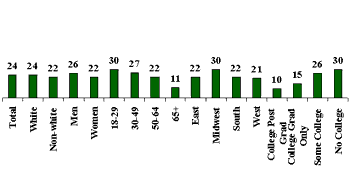 |
| July 9-11, 2002 |
Long-term, smoking has declined in this country. The percentage of adult smokers ranged from 30% to 38% during the 1980s and was 40% or more in the three decades from 1944 through 1974. The high point of smoking was recorded in 1954 when 45% of adults told Gallup they smoked cigarettes.
| Percentage of Cigarette Smokers |
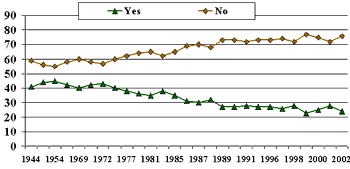 |
In addition to fewer people smoking, polling up until 2001 indicated that smokers are lighting up less frequently than in the past. Between 1999 and 2001, only 9-11% of smokers said they smoke more than a pack of cigarettes per day. This was nearly half the rate recorded as recently as 1997 (20%) and lower still than 1977 (27%). However, Gallup's 2002 survey showed a reversal of this trend, with 17% saying they smoke more than a pack a day.
| Cigarettes Smoked Per Day |
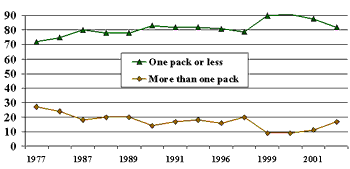 |
Despite the long-term decline in the prevalence of smokers, the rate of adult smoking seems to have reached a plateau at around one quarter in the past decade, rather than continuing to drop. In its Healthy People 2010 initiative, the office of the U.S. Surgeon General has set a goal for reducing the rate of adult smoking in the United States to 12% by the year 2010 -- effectively cutting the rate of smoking in half. However, given the stability of the smoking rate at about 25% for the last decade, it seems unlikely the goal of 12% will be reached that quickly.
At the same time, the rates of teen smoking, which had increased sharply in the mid 1990s, have declined in the past few years. The leading source of data about teen smoking comes from the Monitoring the Future series conducted by the University of Michigan Institute for Social Research (ISR), sponsored by the National Institute on Drug Abuse (one of the National Institutes of Health in the U.S. Department of Health and Human Services).
ISR defines teen smoking as smoking one or more cigarette in the past thirty days. On this basis, smoking among 12th graders declined 2.5% between 2000 and 2001, and has been cut nearly in half since 1996.
According to the ISR data, 2001 cigarette smoking rates for teens are 12.2% among eighth-graders, 21.3% among tenth-graders, and 29.5% among twelfth-graders. The average of these three is 21%, and thus represents a fairly high number. However, these figures are lower than 2000, and are substantially lower compared with the high rates of teen smoking recorded in 1996 and 1997.
| Trends In Teen Smoking Source: Monitoring the Future Survey, ISR |
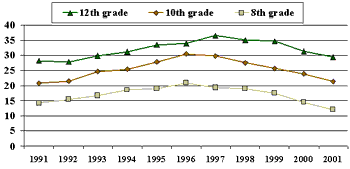 |
ISR researchers note that "the rates of daily current smoking in the three grade levels (defined as having one or more cigarettes per day over the past 30 days) have shown parallel trends to those for any current smoking, and likewise have shown important declines in 2001, specifically." The 2001 survey finds that the rate of daily teen smokers is 5.5% in grade 8, 12.2% in grade 10, and 19.0% in grade 12, for an average of 12%.
The significance of teen smoking is that, according to the Center for Disease Control, most adult smokers started the habit in these early years of their life. Gallup data confirm this. According to Gallup latest survey on tobacco, conducted in July 2002, the average age at which current smokers started using cigarettes is 18. But the median age is 16, meaning that half of all smokers started before they were 16 or younger.
Perhaps as a result, much of the tobacco regulation in the U.S. today -- including limits on sales and advertising -- is aimed at reducing the number of young people who smoke. Yet, despite continued efforts by the Surgeon General and others to reduce smoking among teens, and despite the recent decline in smoking among teens, Gallup has yet to see a reduction in the rate of smoking among young adults.
|
Percent Who Smoked Cigarettes in Past Week
|
||||
|
18-29 |
30-49 |
50-64 |
65+ |
|
|
2002 |
30% |
27 |
22 |
11 |
|
2001 |
41% |
29 |
23 |
17 |
|
2000 |
30% |
26 |
29 |
15 |
|
1989 |
28% |
30 |
31 |
16 |
DO AMERICANS UNDERSTAND THE HEALTH RISKS OF SMOKING?
Gallup first measured public attitudes about the connection between cigarette smoking and lung cancer in January 1954, asking "Have you heard or read anything recently that cigarette smoking may be a cause of cancer of the lung?" At that time -- after medical studies that linked smoking with cancer had been publicized in the news, but before the United States Surgeon General's warnings of the mid-1960s were issued -- 90% of the public told Gallup they had heard of these reports. So the controversy was well publicized. However, when asked in the same poll whether they believed these reports linking tobacco and cancer were accurate, only 41% said they did. Close to one-third believed smoking was not one of the causes of lung cancer while another 29% were unsure.
The trend line below shows the gradual increase in public acceptance of the link between smoking and cancer that occurred over the next 40 years. The most dramatic short-term change in public attitudes on the cancer question occurred between 1960 and 1969, spanning the time when the U.S. Surgeon General issued his first public report on smoking (in 1964) and when Congress required the first warning labels on cigarette packages. At the beginning of the decade only 50% believed smoking was a cause of cancer; by 1969, that figure had grown to 70%. Since then, agreement that smoking causes lung cancer increased by an average of one percentage point per year, and is now held by more than nine in ten Americans -- 92% in the latest poll on this (conducted in 1999).
| Does Smoking Cause Lung Cancer? |
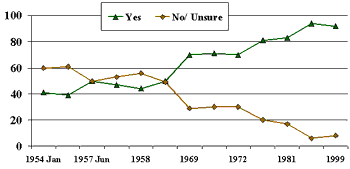 |
The same 1954 poll also found most Americans (70%) answering "yes" to the question "Is smoking harmful?" This was up from 60% who felt this way in 1949.
| Is Smoking Harmful? |
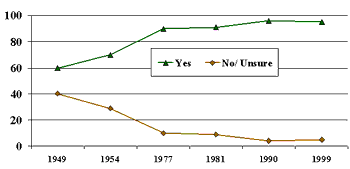 |
However, a follow-up question in 1954 probing the kind of harm Americans thought cigarettes could do, documented that the public was not so well informed about the seriousness of the risks involved. Altogether, only 6% of Americans in 1954 mentioned cancer of any kind as a health risk of smoking. Another 36% mentioned serious health effects such as asthma, or shortening of breath, or that smoking was generally "bad" for the lungs or heart. A majority of Americans-55%-told Gallup that smoking caused a variety of non-life-threatening problems such as coughing, sinus irritation, ulcers, nervousness, and bad breath as well as general complaints such as fatigue.
When asked again by Gallup in 1999, the numbers were markedly different: 33% of Americans mentioned cancer and 74% mentioned a serious health risk of one or another kind, including lung and throat cancer.
Throughout this time period, a rather substantial gap persisted in the percentage of smokers and non-smokers who believed the connection between cigarettes and cancer was true - generally on the order of 20 points. Even in 1977 and 1981, when nationwide belief in the risks of smoking was over 80%, more than one in four smokers continued to doubt the relationship to some degree. In 1990, however, the gap dropped to a low of 10 points, and fell even further in 1999 to just five points (93% of non-smokers believed cigarettes caused cancer vs. 88% of smokers).
Another interesting result along these lines comes from Gallup's 1954 data, showing that the people most convinced that cigarettes could cause lung cancer were former smokers (54%). This compared with 48% of those who never smoked, 32% of light smokers, and only 29% of those who smoked a pack or more a day.
Historically, was this "belief gap" the result of cognitive dissonance reduction among smokers: "I smoke, therefore I can't believe it is harmful?" Or was it indicative of true doubts among smokers about the link between cancer and smoking? If the answer to this complex question can be answered, it could have important implications for ongoing tobacco litigation.
What is your opinion - do you think cigarette smoking is one of the causes of lung cancer?
Percent "Yes" Shown for Years when Smoker/Non-Smoker Data is Available
|
National Adults |
Smokers |
Non-Smokers |
GAP |
|
|
% |
% |
% |
pct. Points |
|
|
1999 |
92 |
88 |
93 |
5 |
|
1990 |
94 |
87 |
97 |
10 |
|
1981 |
83 |
69 |
91 |
22 |
|
1977 |
81 |
72 |
87 |
15 |
|
1969 |
71 |
59 |
78 |
19 |
|
1958 |
45 |
33 |
54 |
21 |
|
1957 |
47 |
35 |
56 |
21 |
|
1954 |
41 |
31 |
49 |
18 |
THE LEGAL ANGLE
In the legal venue, it is difficult for those who began smoking after the first cautionary health labels were posted on cigarette packs (in 1966) to argue that tobacco companies bear responsibility for their habits. Not only does the existence of warning labels undermine that claim, but the congressional act that required warning labels largely shielded the tobacco industry from legal responsibility for new smokers.
But what about people who started smoking before the warning labels? How tenable is the argument made by these individuals that "Big Tobacco" failed to warn them about dangers that were known within the tobacco industry but not to them? A primary issue is whether prior to 1966 the average person should have known, at the time he or she started to smoke, that smoking was associated with increased risk of lung cancer (and possibly many other diseases).
In a 1997 Florida-based lawsuit against tobacco companies involving a woman stricken with lung cancer (Dana Raulerson v. R.J. Reynolds et. al.), the judge's written instructions to the jury stated, "A manufacturer does not have a duty to warn of risks associated with its products when those risks are reasonably known to the average consumers with knowledge common to the community." At what point did "average consumers" understand the risk of contracting lung cancer from smoking cigarettes? Because Dana Raulerson began smoking in 1961, historical data was key.
With the benefit of hindsight, it now seems clear that in the early years of polling on tobacco, public recognition of the link between smoking and deadly cancer was relatively low. Americans may have been aware of the controversy over smoking in the 1950s, as evidenced by the 90% who had heard about it and the 70% who recognized it was harmful in some sense. But widespread acceptance of the serious health risks was many years in coming. A substantial amount of doubt about the risks persisted even in 1969, after two major Surgeon General reports and after the first cautionary labels appeared on cigarette packs.
A Harris poll conducted around the same time clarifies the nature of this doubt. In 1966, only 40% of Americans recognized smoking as a major cause of cancer, and another 27% said it was a minor cause, while fully one-third were unsure, opting for the statement that "science has not yet determined the relation between smoking and lung cancer." Gallup re-asked this question in 2001 and found a major change: now a majority (71%) believes smoking is a major cause of cancer.
| Harris Smoking Risk Question |
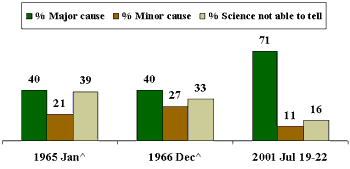 |
| ^ Louis Harris and Associates poll. |
OTHER RISKS ASSOCIATED WITH SMOKING
According to the Centers for Disease Control, it is now well documented that "smoking can cause chronic lung disease, coronary heart disease, and stroke, as well as cancer of the lung, larynx, esophagus, mouth, and bladder," and that "smoking is known to contribute to cancer of the cervix, pancreas, and kidney." The CDC also says "Women who use tobacco during pregnancy are more likely to have adverse birth outcomes, including babies with low birth weight" (a syndrome they report to be the leading cause of death among infants).
The major national public opinion polls have not done an exhaustive job of measuring public awareness of all these risks. Most polls have asked about the nature of the health risks in general terms, or have focused specifically on cancer. One major exception is Gallup's long-term trend on the link between smoking and heart disease that was asked from 1957 through 1997.
Throughout most of this 40-year trend, public awareness of the risk of heart disease lagged behind lung cancer by 10 to 15 percentage points. In 1958 only 33% of Americans recognized heart disease as a risk of smoking, but by 1990 awareness had reached 85%. On the limited occasions that other health risks were probed, knowledge of the risk of throat cancer was similar to that of lung cancer, while the risk of causing birth defects trailed other ailments quite substantially.
What is your opinion - do you think cigarette smoking is one of the causes of (lung cancer/ throat cancer/ heart disease/ birth defects)?
|
Lung Cancer |
Throat Cancer |
Heart Disease |
Birth Defects |
|
|
% |
% |
% |
% |
|
|
1999 Sept |
92 |
90 |
80 |
67 |
|
1990 July |
94 |
--- |
85 |
68 |
|
1981 June |
83 |
81 |
74 |
54 |
|
1977 August |
81 |
79 |
68 |
41 |
|
1969 July |
70 |
--- |
60 |
--- |
|
1960 May |
50 |
--- |
34 |
--- |
|
1958 July |
44 |
--- |
33 |
--- |
|
1957 |
-- |
-- |
38 |
-- |
|
1954 June |
42 |
--- |
--- |
--- |
|
1954 January |
42 |
--- |
--- |
--- |
THE ADDICTION FACTOR
Whatever their number, adult smokers today can no longer credibly claim they are not aware that their behavior jeopardizes their health. But do they accurately estimate the extent of the risk? Are they aware of all the medical risks, not just cancer? Did they understand their chances of becoming addicted to cigarettes when they started smoking?
Addiction is a key issue in tobacco litigation. Regardless of whether tobacco addiction is physiological, psychological or some combination, or whether it is manipulated by the addition of nicotine to cigarettes, most smokers (74%) say that the specific label "addicted" applies to their situation. This is up from 61% in 1990 who described themselves as addicted -- perhaps a result of publicity surrounding plaintiffs' claims in cases against the tobacco industry.
What do smokers' efforts to quit tell us about the possible rate of "addiction?" A large majority (82%) of smokers tell Gallup they would like to quit, and nearly as many (74%) say they have tried to quit. At the same time, most smokers (69% in 1993) remain optimistic that they can quit. Only 12% of current smokers say they would start smoking if they could "do it over again."
SECOND-HAND SMOKE
A new aspect of the smoking issue in the last few decades is second-hand smoke -- that is, the possible health effects on non-smokers of exposure to cigarette smoke. Public concern about this grew rapidly in the mid-1990s, but has subsequently leveled off. When Gallup first asked Americans in 1994 to rate the seriousness of the risk posed to non-smoking adults from tobacco smoke, only 36% considered second-hand smoke "very harmful," 42% said "somewhat harmful," and 18% believed it was "not too harmful." By 1996, however, the "very harmful" figure had risen to 48% and it reached 55% in 1997. After receding in 1999, the latest measure, in 2002, found 56% rating second-hand smoke "very harmful."
| How Harmful Is Second-Hand Smoke? |
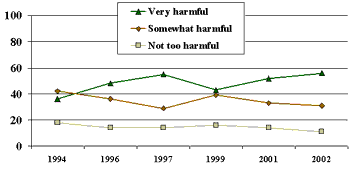 |
GOVERNMENT REGULATION GENERALLY SUPPORTED
A broad review of polling about tobacco indicates that, historically, the public has generally supported governmental efforts to regulate smoking. Shortly after cigarette ads were banned on TV and radio in 1969, two-thirds of Americans in a Louis Harris and Associates survey rated Congress' work in this area as "excellent" or "pretty good." A poll conducted by the American Medical Association in 1987 -- the same year smoking was banned on airline flights of two hours or less -- found two-thirds of Americans in favor of banning all smoking on domestic trips. A Gallup poll in 1990, one year after that ban was extended to flights under six hours, found the public even more supportive of a total ban, with 78% in favor.
Americans have long showed support for even more stringent regulation of smoking in public, going well beyond regulation of airline and teen smoking. A 1976 Roper Organization poll found that 51% of Americans favored banning smoking in public places, with 44% opposed. Then, in 1982 the American Cancer Society issued its first major report on the hazards of second-hand smoke, saying that secondary exposure was correlated with increased mortality from lung cancer and heart disease. From this point, the campaign to ban smoking from public buildings and workplaces essentially was launched. Over the next 15 years, various polls showed that support for such bans increasing to two-thirds of Americans when asked about such bans generally.
Polling on the subject of teen smoking, long a target of government laws and regulations at every level, shows widespread public support for restrictions on the sale and marketing of cigarettes to minors. As early as 1962, a Gallup poll found 79% of Americans in favor of making it illegal to sell cigarettes to children under age 16, and 57% in favor of making it illegal for children to smoke at all. In 1995 the Associated Press found 74% favored requiring the tobacco industry to spend millions on anti-smoking campaigns targeted at teens. A 1997 Princeton Survey Research Associates survey found 87% in favor of strengthening enforcement of laws prohibiting the sale of tobacco to minors. Many other polls reinforce the point that from 70% to 80% of the public supports government restrictions on smoking among minors.
SMOKING IN PUBLIC
A 1997 American Medical Association survey found, by a 76% to 10% margin, that "the right of non-smokers to a smoke-free environment" is viewed as more important than "the right of smokers to smoke anywhere."
Nevertheless, polling finds little support for prohibiting all smoking in public. A 1997 ABC News poll asked: "Do you think the government should make smoking illegal in all places--indoors and out--except smoker's own home?" Only 33% of Americans at that time favored this extreme proposal.
A Gallup question initiated in 1987 has probed attitudes about smoking in public and records some nuances about the places Americans are willing to tolerate smoking. When given the choice, Americans tend to favor designated smoking areas in public establishments, rather than support an outright ban on smoking. However, the trends on this have been gradually shifting toward less tolerance -- particularly when it comes to restaurants.
In 1987 only 10% of the public thought smoking should be completely banned in hotels and motels, 17% thought it should be disallowed in the workplace, and an equal number thought it should be prohibited in restaurants. However, by 2001, those figures had increased to 27%, 38% and 44% respectively.
A majority of Americans still believe hotels and motels should provide special areas for smokers (65%), as should workplaces (57%), but less than half (48%) now favor set-aside areas in restaurants.
| Smoking in Public |
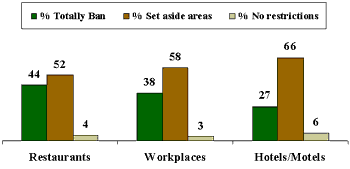 |
| July 19-22, 2001 |
The following tables show the breakdown in attitudes between smokers and non-smokers toward smoking in various places looks like this. Most noteworthy is that a majority of non-smokers believe that smoking should be banned in all restaurants, compared to only 22% of smokers who feel this way. A large gap in preferences for dealing with smoking in the workplace also exists between the two groups. They are more in agreement with respect to hotels/motels, with most supporting the establishment of special smoking areas in these establishments.
|
Smoking in Restaurants, 2001 |
||
|
Smokers |
Non-smokers |
|
|
Ban |
22 |
53 |
|
Set aside |
69 |
45 |
|
No restrictions |
8 |
2 |
|
Smoking in Workplaces, 2001 |
||
|
Smokers |
Non-smokers |
|
|
Ban |
17 |
46 |
|
Set aside |
76 |
51 |
|
No restrictions |
5 |
2 |
|
Smoking in Hotels/Motels, 2001 |
||
|
Smokers |
Non-smokers |
|
|
Ban |
10 |
34 |
|
Set aside |
77 |
61 |
|
No restrictions |
12 |
4 |
THE RIGHT TO SMOKE IS ENTRENCHED
The public's consistent support for restrictions that would protect both non-smokers and underage smokers should not be construed as rampant anti-smoking zealotry. In a 1994 Gallup poll, only 11% of Americans felt smoking should be made totally illegal in the US. Similarly, Harris and Time/CNN surveys have recorded solid support for preserving the right to smoke.
When forced to choose between the competing interests of individuals and society, three-quarters or more of Americans say, in a variety of polls, that the individual's right to smoke should prevail over the social benefits that might be gained by banning it. This is clear in a 1998 Time/CNN survey that found widespread public agreement with the statement "everyone should have the right to make his or her own choice about whether to smoke" rather than with the statement "smoking is a bad habit and our society should do everything possible to stamp it out."
REGULATION BY FDA GETS MIXED REVIEWS
Considering these findings, it is not surprising that the public has not been quick to embrace federal regulation of the production and distribution of tobacco products. David Kessler, former head of The Federal Drug Administration in the Clinton administration, contended that cigarettes are addictive and that their addictive power is deliberately controlled in the manufacturing process through the addition of nicotine. On that basis Kessler advocated classifying cigarettes as a drug and bringing them under the jurisdiction of his agency so that the FDA could regulate the manufacture and sale of cigarettes as it does prescription drugs.
Polling, however, reveals some public resistance to this proposal. A 1999 survey by EDK Associates finds 69% of Americans agreeing "tobacco corporations should be regulated by the Food and Drug Administration" and only 25% disagreeing. However, in 1998 the Pew Research Center found only 41% of Americans calling this proposal "very important" for the country while 56% described it as less important. And a 1998 survey by Gallup for SmithKline Beecham found only 43% agreeing that "there should be greater regulation of the tobacco industry by the government," while 57% disagreed.
Perhaps this lack of intensity in the public's attitudes on the issue explains the results of a 1996 Gallup poll conducted at the height of public debate over Kessler's proposal. That survey found only 38% in favor of new tobacco regulation while 57% preferred that the government not classify tobacco as a drug but allow it to be sold and used as it is now. As expected, support for such FDA regulation was particularly slim among smokers (21%). Non-smokers were split on the question with 48% on each side of the issue. However, a somewhat differently worded Gallup question on the same subject in 1998, found a slim majority of Americans, 51%, in favor of "classifying nicotine as a drug so that it can be regulated by the same government agency that regulates prescription drugs." While the results seem contradictory, in both cases the public seems to tilt toward prevailing practices: in the wording of 1996 question the status quo appeared to be non-regulation of tobacco; in the 1998 question it was current regulation of prescription drugs.
A more recent survey sponsored by National Public Radio, Harvard University and the Henry P. Kaiser foundation finds the public's appetite for increased regulation of tobacco to be rather low. According to this poll, conducted May/June 2000, only 37% of Americans think there is "not enough" government regulation of tobacco. Another third (31%) think there is the "right amount" of regulation in this area while almost an equal number (30%) thinks there is too much.
SMOKERS ARE RESPONSIBLE, BUT GOVERNMENT CAN RECOUP COSTS
In recent years, anti-tobacco measures have spread from government to the courtroom. Smokers and the families of deceased smokers have lined up to sue cigarette manufacturers over death or serious illnesses allegedly caused by tobacco, and most states have also filed suit against cigarette manufacturers to recoup state health care costs attributed to patients with smoking-related illnesses.
Polling data offers little doubt that tobacco companies are an unpopular group. For instance, the September 2000 Harvard/Kaiser Family Foundation poll found only 23% of Americans holding a favorable view of tobacco companies while 71% hold and unfavorable view. The same poll found 76% of Americans believing that tobacco companies "make too much profit."
Nevertheless, current polling finds Americans quite unsympathetic to the plaintiffs' arguments in these cases, with the public saying that smokers -- not tobacco companies -- are to blame for the consequences of their decisions to smoke. In a 1989 Gallup poll, only 16% of Americans said tobacco companies should be held responsible for smokers' health problems, while 79% said they should not. More than a decade later, Gallup found relatively little change in this sentiment. In answer to the question "Who's to blame for the health problems faced by smokers in this country?" only 29% of Americans implicated cigarette makers, with 6% saying they are completely to blame and 23% saying they are mostly to blame. By contrast, 62% fault smokers themselves -- including 27% who say they are completely to blame and 35% who say they are mostly to blame. And when asked by ABC News in 1999 whether tobacco companies should have to pay "money damages" to people who develop smoking-related illnesses, only 34% felt they should, while 60% felt they should not.
Despite this, Americans do tend to support government efforts to recoup smoking-related health care costs from tobacco companies. In 1999 the Justice Department filed a lawsuit against the tobacco industry seeking to recover billions of dollars in federal health costs for smoking-related illnesses. At the time Gallup found 51% of the public siding with the Justice Department in the suit while just 42% sided with the tobacco companies who argued the case had no merit.
Similarly, Gallup's July 2002 survey on smoking tested the public's support for raising cigarette taxes in order to help state and local governments pay for the health costs related to smoking. A majority of Americans (55%) said that cigarette taxes should be raised for this purpose, although not surprisingly the measure is widely supported by non-smokers and widely opposed by smokers.
DETERRING TEEN SMOKING IS SEEN AS DIFFICULT
One recent Gallup Poll found 87% of the public in favor of putting severe restrictions on the advertising and sale of cigarettes to minors. Most Americans tell pollsters they have an unfavorable view of tobacco companies (71% in the 2000 Harvard/Kaiser Family Foundation poll), and that they believe tobacco companies encourage teenagers to smoke. A 1997 Harris poll found 80% saying they think tobacco companies purposely target kids in their advertising. Yet, polls suggests only a third of Americans believe anti-smoking measures (such as the kind proposed in the 1998 tobacco settlement bill in Congress) would be effective at reducing teen smoking.
After the death of a major tobacco settlement bill in the U.S. Senate in 1998 -- which would have raised taxes on cigarettes to pay, in part, for expanded government anti-smoking programs -- an ABC News poll found only a third of the public believing the bill would have reduced teen smoking while two-thirds doubted it. Similarly a CBS News poll in 1997 found only 19% of Americans optimistic that any future settlement between the government and the tobacco industry would significantly reduce the number of teenagers who begin smoking.
SMOKING: CHOICE AND RESPONSIBILITY
Through the complex web of opinions recorded by the polling industry on the topic of smoking, what Americans seem to be saying is that adult smoking is an individual's right, their choice, and their responsibility. That sentiment works in smokers' favor when it comes to keeping tobacco legal, but it works against them in cigarette liability cases. It even works against long-time smokers who might, it seems from the historical trends, have a legitimate claim based on the fact that they picked up the habit 40 or more years ago when the risk of lung cancer was widely underestimated and poorly understood.
In terms of regulations on smoking in public, the tenuous balance between preserving the freedom to smoke and protecting non-smokers and society from the health and financial consequences of smoking seems to be holding. Smokers seem to be accepting the continuous wave of new government restrictions. In 2002, 58% of smokers said that public smoking restrictions were justified, while only 39% felt "unjustly discriminated against." These figures are nearly identical to how smokers felt in 1994. At the same time, non-smokers seem sympathetic to the rights and convenience of smokers in many areas. Although tolerance of smoking in restaurants is rapidly shrinking, Americans still favor the accommodation of smokers in the workplace and hotels.
One public policy smokers are more vexed about is taxation, as four in five smokers (79%) feel that cigarette taxes are too high, while the majority of non-smokers believe they are either about right (31%) or too low (34%). Similarly, two thirds of smokers (68%) say they feel unjustly discriminated against by increased taxes on cigarettes. Nevertheless, only 27% of smokers say they are smoking less because of these taxes; this is similar to the 28% who say they are smoking less because of restrictions on the use of tobacco in public places.